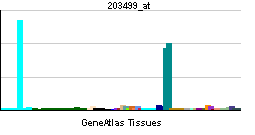EPH receptor A2
| EPH receptor A2 | |||||||||||||
|---|---|---|---|---|---|---|---|---|---|---|---|---|---|
 PDB rendering based on 1mqb. | |||||||||||||
| |||||||||||||
| Identifiers | |||||||||||||
| Symbols | EPHA2 ; ECK | ||||||||||||
| External IDs | Template:OMIM5 Template:MGI HomoloGene: 20929 | ||||||||||||
| |||||||||||||
| RNA expression pattern | |||||||||||||
 | |||||||||||||
| More reference expression data | |||||||||||||
| Orthologs | |||||||||||||
| Template:GNF Ortholog box | |||||||||||||
| Species | Human | Mouse | |||||||||||
| Entrez | n/a | n/a | |||||||||||
| Ensembl | n/a | n/a | |||||||||||
| UniProt | n/a | n/a | |||||||||||
| RefSeq (mRNA) | n/a | n/a | |||||||||||
| RefSeq (protein) | n/a | n/a | |||||||||||
| Location (UCSC) | n/a | n/a | |||||||||||
| PubMed search | n/a | n/a | |||||||||||
EPH receptor A2, also known as EPHA2, is a human gene.[1]
This gene belongs to the ephrin receptor subfamily of the protein-tyrosine kinase family. EPH and EPH-related receptors have been implicated in mediating developmental events, particularly in the nervous system. Receptors in the EPH subfamily typically have a single kinase domain and an extracellular region containing a Cys-rich domain and 2 fibronectin type III repeats. The ephrin receptors are divided into 2 groups based on the similarity of their extracellular domain sequences and their affinities for binding ephrin-A and ephrin-B ligands. This gene encodes a protein that binds ephrin-A ligands.[2]
References
- Flanagan JG, Vanderhaeghen P (1998). "The ephrins and Eph receptors in neural development". Annu. Rev. Neurosci. 21: 309–45. doi:10.1146/annurev.neuro.21.1.309. PMID 9530499.
- Zhou R (1998). "The Eph family receptors and ligands". Pharmacol. Ther. 77 (3): 151–81. PMID 9576626.
- Holder N, Klein R (1999). "Eph receptors and ephrins: effectors of morphogenesis". Development. 126 (10): 2033–44. PMID 10207129.
- Wilkinson DG (2000). "Eph receptors and ephrins: regulators of guidance and assembly". Int. Rev. Cytol. 196: 177–244. PMID 10730216.
- Xu Q, Mellitzer G, Wilkinson DG (2001). "Roles of Eph receptors and ephrins in segmental patterning". Philos. Trans. R. Soc. Lond., B, Biol. Sci. 355 (1399): 993–1002. doi:10.1098/rstb.2000.0635. PMID 11128993.
- Wilkinson DG (2001). "Multiple roles of EPH receptors and ephrins in neural development". Nat. Rev. Neurosci. 2 (3): 155–64. PMID 11256076.
- Kinch MS, Carles-Kinch K (2003). "Overexpression and functional alterations of the EphA2 tyrosine kinase in cancer". Clin. Exp. Metastasis. 20 (1): 59–68. PMID 12650608.
- Walker-Daniels J, Hess AR, Hendrix MJ, Kinch MS (2003). "Differential regulation of EphA2 in normal and malignant cells". Am. J. Pathol. 162 (4): 1037–42. PMID 12651595.
- Lindberg RA, Hunter T (1991). "cDNA cloning and characterization of eck, an epithelial cell receptor protein-tyrosine kinase in the eph/elk family of protein kinases". Mol. Cell. Biol. 10 (12): 6316–24. PMID 2174105.
- Pandey A, Shao H, Marks RM; et al. (1995). "Role of B61, the ligand for the Eck receptor tyrosine kinase, in TNF-alpha-induced angiogenesis". Science. 268 (5210): 567–9. PMID 7536959.
- Pandey A, Duan H, Dixit VM (1995). "Characterization of a novel Src-like adapter protein that associates with the Eck receptor tyrosine kinase". J. Biol. Chem. 270 (33): 19201–4. PMID 7543898.
- Ruiz JC, Robertson EJ (1994). "The expression of the receptor-protein tyrosine kinase gene, eck, is highly restricted during early mouse development". Mech. Dev. 46 (2): 87–100. PMID 7918100.
- Davis S, Gale NW, Aldrich TH; et al. (1994). "Ligands for EPH-related receptor tyrosine kinases that require membrane attachment or clustering for activity". Science. 266 (5186): 816–9. PMID 7973638.
- Pandey A, Lazar DF, Saltiel AR, Dixit VM (1994). "Activation of the Eck receptor protein tyrosine kinase stimulates phosphatidylinositol 3-kinase activity". J. Biol. Chem. 269 (48): 30154–7. PMID 7982920.
- Ganju P, Shigemoto K, Brennan J; et al. (1994). "The Eck receptor tyrosine kinase is implicated in pattern formation during gastrulation, hindbrain segmentation and limb development". Oncogene. 9 (6): 1613–24. PMID 8183555.
- Gale NW, Holland SJ, Valenzuela DM; et al. (1996). "Eph receptors and ligands comprise two major specificity subclasses and are reciprocally compartmentalized during embryogenesis". Neuron. 17 (1): 9–19. PMID 8755474.
- Sulman EP, Tang XX, Allen C; et al. (1997). "ECK, a human EPH-related gene, maps to 1p36.1, a common region of alteration in human cancers". Genomics. 40 (2): 371–4. doi:10.1006/geno.1996.4569. PMID 9119409.
- Kozlosky CJ, VandenBos T, Park L; et al. (1997). "LERK-7: a ligand of the Eph-related kinases is developmentally regulated in the brain". Cytokine. 9 (8): 540–9. doi:10.1006/cyto.1997.0199. PMID 9245480.
- "Unified nomenclature for Eph family receptors and their ligands, the ephrins. Eph Nomenclature Committee". Cell. 90 (3): 403–4. 1997. PMID 9267020.
| This protein-related article is a stub. You can help Wikipedia by expanding it. |